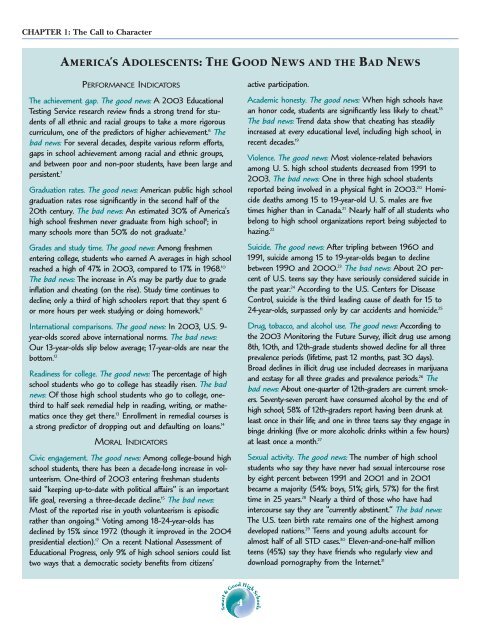Smart & Good High Schools - The Flippen Group
Smart & Good High Schools - The Flippen Group
Smart & Good High Schools - The Flippen Group
- No tags were found...
Create successful ePaper yourself
Turn your PDF publications into a flip-book with our unique Google optimized e-Paper software.
CHAPTER 1: <strong>The</strong> Call to CharacterAMERICA’S ADOLESCENTS: THE GOOD NEWS AND THE BAD NEWSPERFORMANCE INDICATORS<strong>The</strong> achievement gap. <strong>The</strong> good news: A 2003 EducationalTesting Service research review finds a strong trend for studentsof all ethnic and racial groups to take a more rigorouscurriculum, one of the predictors of higher achievement. 6 <strong>The</strong>bad news: For several decades, despite various reform efforts,gaps in school achievement among racial and ethnic groups,and between poor and non-poor students, have been large andpersistent. 7Graduation rates. <strong>The</strong> good news: American public high schoolgraduation rates rose significantly in the second half of the20th century. <strong>The</strong> bad news: An estimated 30% of America’shigh school freshmen never graduate from high school 8 ; inmany schools more than 50% do not graduate. 9Grades and study time. <strong>The</strong> good news: Among freshmenentering college, students who earned A averages in high schoolreached a high of 47% in 2003, compared to 17% in 1968. 10<strong>The</strong> bad news: <strong>The</strong> increase in A’s may be partly due to gradeinflation and cheating (on the rise). Study time continues todecline; only a third of high schoolers report that they spent 6or more hours per week studying or doing homework. 11International comparisons. <strong>The</strong> good news: In 2003, U.S. 9-year-olds scored above international norms. <strong>The</strong> bad news:Our 13-year-olds slip below average; 17-year-olds are near thebottom. 12Readiness for college. <strong>The</strong> good news: <strong>The</strong> percentage of highschool students who go to college has steadily risen. <strong>The</strong> badnews: Of those high school students who go to college, onethirdto half seek remedial help in reading, writing, or mathematicsonce they get there. 13 Enrollment in remedial courses isa strong predictor of dropping out and defaulting on loans. 14MORAL INDICATORSCivic engagement. <strong>The</strong> good news: Among college-bound highschool students, there has been a decade-long increase in volunteerism.One-third of 2003 entering freshman studentssaid “keeping up-to-date with political affairs” is an importantlife goal, reversing a three-decade decline. 15 <strong>The</strong> bad news:Most of the reported rise in youth volunteerism is episodicrather than ongoing. 16 Voting among 18-24-year-olds hasdeclined by 15% since 1972 (though it improved in the 2004presidential election). 17 On a recent National Assessment ofEducational Progress, only 9% of high school seniors could listtwo ways that a democratic society benefits from citizens’active participation.Academic honesty. <strong>The</strong> good news: When high schools havean honor code, students are significantly less likely to cheat. 18<strong>The</strong> bad news: Trend data show that cheating has steadilyincreased at every educational level, including high school, inrecent decades. 19Violence. <strong>The</strong> good news: Most violence-related behaviorsamong U. S. high school students decreased from 1991 to2003. <strong>The</strong> bad news: One in three high school studentsreported being involved in a physical fight in 2003. 20 Homicidedeaths among 15 to 19-year-old U. S. males are fivetimes higher than in Canada. 21 Nearly half of all students whobelong to high school organizations report being subjected tohazing. 22Suicide. <strong>The</strong> good news: After tripling between 1960 and1991, suicide among 15 to 19-year-olds began to declinebetween 1990 and 2000. 23 <strong>The</strong> bad news: About 20 percentof U.S. teens say they have seriously considered suicide inthe past year. 24 According to the U.S. Centers for DiseaseControl, suicide is the third leading cause of death for 15 to24-year-olds, surpassed only by car accidents and homicide. 25Drug, tobacco, and alcohol use. <strong>The</strong> good news: According tothe 2003 Monitoring the Future Survey, illicit drug use among8th, 10th, and 12th-grade students showed decline for all threeprevalence periods (lifetime, past 12 months, past 30 days).Broad declines in illicit drug use included decreases in marijuanaand ecstasy for all three grades and prevalence periods. 26 <strong>The</strong>bad news: About one-quarter of 12th-graders are current smokers.Seventy-seven percent have consumed alcohol by the end ofhigh school; 58% of 12th-graders report having been drunk atleast once in their life; and one in three teens say they engage inbinge drinking (five or more alcoholic drinks within a few hours)at least once a month. 27Sexual activity. <strong>The</strong> good news: <strong>The</strong> number of high schoolstudents who say they have never had sexual intercourse roseby eight percent between 1991 and 2001 and in 2001became a majority (54%: boys, 51%; girls, 57%) for the firsttime in 25 years. 28 Nearly a third of those who have hadintercourse say they are “currently abstinent.” <strong>The</strong> bad news:<strong>The</strong> U.S. teen birth rate remains one of the highest amongdeveloped nations. 29 Teens and young adults account foralmost half of all STD cases. 30 Eleven-and-one-half millionteens (45%) say they have friends who regularly view anddownload pornography from the Internet. 31<strong>Smart</strong> & <strong>Good</strong> <strong>High</strong> <strong>Schools</strong>4















